Home | Category: Molluscs and Gastropods (Sea Shells)
GIANT CLAMS
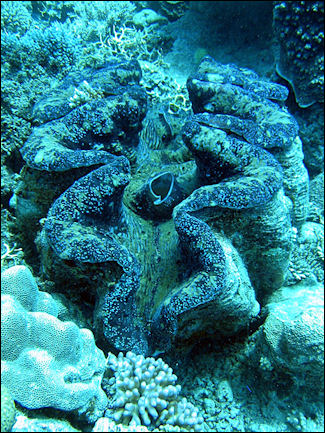
giant clam Giant clams are the largest of all bivalves. They can reach a width of 1.4 meters (4.5) feet and weigh 230 kilograms (500 pounds. Found in the Pacific and Indian Oceans, they grow from 15 centimeters to 40 centimeters across in three years and can be over 100 years old.
Giant clams are members of the Subfamily Tridacninae, which consists of two genera: Hippopus and Tridacna. They clams typically inhabit tropical coral reefs in coastal regions throughout the Indo-Pacific Ocean. Seven of the ten known species of giant clams in the world are found in the coral reefs of the South China Sea. Tridacna gigas is the most commonly intended species referred to as "the giant clam" but other species in the genera Tridacna and Hippopus are also called of "giant clams"
Tridacna gigas is one of the most endangered clam species. Antonio Pigafetta, who was on Magellan's round the world trip, documented it in his journal as early as 1521.
Also known as horse's hoof clams and bear paw clams, giant clams in the reef lie embedded in the coral. When you see one you hardly notice its shell, instead what you see is it the fleshy mantle lips, which extend outside the shell and come in a dazzling array of purple, orange and green polka dots and stripes. When the clam's shell is open streams of water are emitted with siphons as large as "garden hoses."┭
Giant clams are integral and colorful members of the Indo-Pacific coral reef ecosystems. Their brilliantly-colored mantlespulsate gently as water is pumped through them. Giant clams can't close their shells very tightly or quickly. They present no real danger to humans as some cartoon pictures suggest. If for some strange reason you were to get an arm or leg caught in one, it could be very easily removed.
Websites and Resources: Animal Diversity Web (ADW) animaldiversity.org; National Oceanic and Atmospheric Administration (NOAA) noaa.gov; Fishbase fishbase.se ; Encyclopedia of Life eol.org ; Smithsonian Oceans Portal ocean.si.edu/ocean-life-ecosystems
Giant Clam Habitat and Where They Are Found
Giant clams are native to the Pacific Ocean and Indian Ocean. The range from the South China Sea in the north to the northern coasts of Australia in the south and from the Nicobar Islands off India in the west to Fiji in the east. They have traditionally been abundant in waters around the Philippines, in the South China Sea in the coral reefs of Sabah (Malaysian Borneo) and some Pacific island but are now less common than they once were. [Source: Kari Tervo and Rebecca Ann Csomos, Animal Diversity Web (ADW) /=]
You typically find giant clams in reefs or other coastal areas from the ocean surface to depths of less than 20 meters of the surface. They are most common found in shallow lagoons and reef flats, and are typically embedded in sandy substrates or those composed of coral rubble. Adults are permanently anchored in one place. /=\
Populations have diminished quickly, and the giant clam has become extinct in many areas where it was once common. The maxima clam has the largest geographical distribution among giant clam species; it can be found off high- or low-elevation islands, in lagoons or fringing reefs. Its rapid growth rate is likely due to its ability to cultivate algae in its body tissue.
Largest Giant Clams
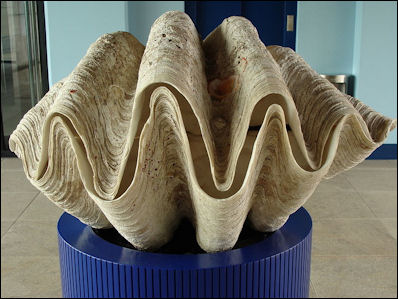
giant clam The largest sea shell ever found was a 333 kilograms giant clam found near Okinawa, Japan. It was discovered in 1956 off the island of Ishigaki but was not examined scientifically until 1984. The shell was 1.15 meters (3 feet 9 inches) wide and the weight of the shells and soft parts was 333 kilograms (734 pounds). Scientists estimated the live weight to be around 340 kilograms (750 pound).
The largest known T. gigas specimen measured 1.37 meters (4 feet 6 inches). It was discovered around 1817 on the north western coast of Sumatra, Indonesia. Its shells are now on display in a museum in Northern Ireland. The joint weight of the two shells is 230 kilograms (510 pounds), which suggests that the live weight of the animal would have been roughly 250 kilograms (550 pounds).
Giant clams are also world record egg producers. A single female giant clam can produce one billion eggs when spawning and they perform this feat every year for 30 or 40 years.
Giant Clam Characteristics
Giant clams are highly derived cardiids (cockles) whose adult morphology has been profoundly restructured by their long evolutionary association with symbiotic relationship with the algae that grows in their mantle and provides them with food.The shells of giant Clams can have a grayish or golden brown and reddish brown color with ripple appearance.
Giant clams are cold blooded (ectothermic, use heat from the environment and adapt their behavior to regulate body temperature). According to Animal Diversity Web: They are characterized by having 4 to five large, inward facing triangular projections of the shell aperture, thick, heavy shells without scutes (juveniles may have some scutes), and an inhalent siphon with no tentacles. [Source: Kari Tervo and Rebecca Ann Csomos, Animal Diversity Web (ADW) /=]
The mantle is usually golden brown, yellow, or green, with many irridescent blue, purple, or green spots, especially around the mantle edges. Larger individuals may have so many of these spots that the mantle appears solid blue or purple. Giant clams also have many pale or clear spots on the mantle, referred to as 'windows'. Giant clams cannot completely close their shell once fully grown. If disturbed, the brightly colored mantle tissue (containing zooxanthellae) is retracted and the shell valves are closed. /=\
Giant Clam Food
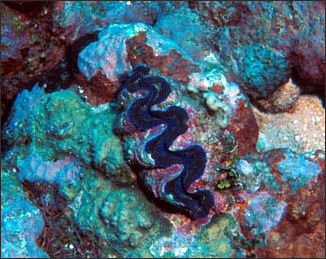
giant clam Giant clams are capable of filtering food — including microscopic marine plants (phytoplankton) and animals (zooplankton) — from sea water, using their ctenidia ("gills"), like other clams but they get 90 percent of their food from the same symbiotic algae that feeds coral. Colonies of algae grow in special compartments within the mantle of giant clams. Between the bright colors are transparent patches that focus light on the algae, which produced food for the clams. The mantle of the giant clam is like a garden for algae. A surprising number of other animals nurture internal algae too, from sponges to thin-skinned flatworms.
According to Animal Diversity Web the photosymbionts living within the giant clam's tissues "are unicellular algae (often called zooxanthellae) that are farmed by the mollusk host in much the same way that corals do. In some Tridacna gigas, the zooxanthellae have been shown to provide 90 percent of the carbon chains metabolized. This is an obligate association for the clam and it will die in the absence of the zooxanthellae, or if kept in the dark. The presence of 'windows' in the mantle may function to allow more light into mantle tissues to fuel zooxanthellae photosynthesis. [Source: Kari Tervo and Rebecca Ann Csomos, Animal Diversity Web (ADW) /=]
As is true is true with coral leaving behind calcium carbonate shells to create coral reef, the zooxanthellae in giant clams leaves large amounts of calcium carbonate which thickens the giant clams’ shells. The mantle's edges are packed with symbiotic zooxanthellae that presumably utilize carbon dioxide, phosphates, and nitrates supplied by the clam.
Giant Clam Reproduction and Development
Giant clams reproduce sexually via broadcast spawning. They expel sperm and eggs into the sea. Fertilization takes place in open water and is followed by a planktonic larval stage. The larvae (veligers) must swim and feed in the water column until they are sufficiently developed to settle on a suitable substrate, usually sand or coral rubble, and begin their adult life as a sessile clam. [Source: Kari Tervo and Rebecca Ann Csomos, Animal Diversity Web (ADW) /=] /=\
Giant clams reproduce sexually and are hermaphrodites (producing both eggs and sperm). Self-fertilization is not possible, but they can reproduce with any other member of the species that are nearby. A transmitter substance called spawning induced substance (SIS) helps synchronize the release of sperm and eggs to ensure fertilization. Detection of SIS stimulates the giant clam to swell its mantle in the central region and to contract its adductor muscles. Each clam fills its water chambers and closes the incurrent syphon. After a few contractions containing only water, eggs and sperm appear in the excurrent chamber and then pass through the excurrent syphon into the water. Female eggs have a diameter of 100 micrometres (0.0039 inches). Egg release initiates the reproductive process. An adult giant clam can release more than 500 million eggs at a time. Spawning seems to coincide with incoming tides near the second (full), third, and fourth (new) quarters of the moon phase. [Source: Wikipedia]
The fertilized egg floats in the sea for about 12 hours until eventually a larva (trochophore) hatches. It then starts to produce a calcium carbonate shell. Two days after fertilization it measures 160 micrometres (0.0063 inches). Soon it develops a "foot," which is used to move on the ground; it can also swim to search for appropriate habitat. At roughly one week of age, the clam settles on the ground, although it changes location frequently within the first few weeks. The larva does not yet have symbiotic algae, so it depends completely on plankton. Free floating zooxanthellae are also captured while filtering food. Eventually the front adductor muscle disappears and the rear muscle moves into the clam's center. Many small clams die at this stage. The clam is considered a juvenile when it reaches a length of 20 centimeters (8 inches). It is difficult to observe the growth rate of T. gigas in the wild, but laboratory-reared giant clams have been observed to grow 12 centimeters (4.7 inches) a year.
Humans and Giant Clams
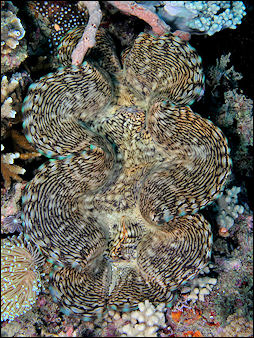
giant clam Despite their characterization as "killer clams" in B movies, there has never been verified case of a person being trapped and drowned by giant clams. Giant clams are actually quite lethargic and slow about closing. The most common injuries associated with them are hernias, back injuries, and smashed toes caused when people lift adult clams out of the water unaware of how heavy they are. [Source: Kari Tervo and Rebecca Ann Csomos, Animal Diversity Web (ADW) /=]
The giant clam is considered a delicacy in Japan (where it is known as himejako), France, Southeast Asia and many Pacific Islands. Some Asian foods include the meat from the muscles of clams. On the black market, giant clam shells are sold as decorative accoutrements. At times large amounts of money were paid for the adductor muscle, which Chinese people believed have aphrodisiac powers. [Source: Wikipedia]
Giant clams, or hima in the Chamoru language of the Mariana Islands, are an important part of Guam’s culture. Archaeological findings show that the island’s people used clam shells for tools such as adzes, scrapers, and knives. They also incorporated the shells into body ornamentation and precious jewelry, including sinahi, a crescent moon necklace that’s a symbol of CHamoru pride and culture. Today, hima are still harvested for meat and jewelry (often sold within the community and to tourists), but they’ve become a regulated species due to overharvesting. [Source: NOAA]
Threatened Giant Clams
Giant clams are listed as vulnerable by the International Union for Conservation of Nature (IUCN) because of extensive collecting for food, aquaculture, and the aquarium trade. Numbers in the wild have been greatly reduced. They have been severely over-harvested throughout much of their collective range and illegal fishing and poaching remain serious problems.
Currently, seven giant clam species are candidate species for listing under the U.S. Endangered Species Act. This includes two species in the genus Hippopus (H. hippopus and H. porcellanus) and five species in the genus Tridacna (T. derasa, T. gigas, T. mbalavuana (tevoroa), T. squamosa, and T. squamosina (costata). [Source: NOAA]
Giant clams have been placed in the Convention on International Trade in Endangered Species (CITES) Appendix II, which lists species not necessarily threatened with extinction now but may become so unless trade is closely controlled: Throughout Its range. Threats include climate change, disease, habitat degradation, illegal trade and poaching, overfishing, sedimentation and pollution
Giant Clam Aquaculture
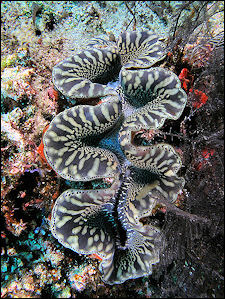
giant clam Eight species of giant clams are currently being cultured. Aquaculture ventures have diverse aims that include conservation and restocking programs. Farmed giant clams are also sold for food (the adductor muscle is considered a delicacy) and for the aquarium trade. [Source: Kari Tervo and Rebecca Ann Csomos, Animal Diversity Web (ADW) /=]
A NOAA-funded, grant project in Guam is setting up giant clam aquaculture in two southern villages, Inalåhan and Malesso. Giant clams are a culturally important species in Guam, where they’re also regulated due to overharvesting. The aim of the project is creating community-run aquaculture for giant clams, providing food and jobs and supporting cultural practices. [Source: NOAA]
A 2021 pilot project, in collaboration with Inalåhan Mayor Anthony Chargualaf, planted giant clams collected from various Guamanian reefs into Inalåhan tide pools. For the new project, the Aquaculture Association of Palau is supplying DAWR with 1,000 giant clams, some of which will serve as broodstock for future projects. DAWR will provide the villages with the necessary materials and knowledge for hima aquaculture, including equipment to construct the farm and in-water cages. The villages will be responsible for constructing and managing the farm.
Image Sources: Wikimedia Commons, NOAA
Text Sources: Animal Diversity Web (ADW) animaldiversity.org; National Oceanic and Atmospheric Administration (NOAA) noaa.gov; Wikipedia, National Geographic, Live Science, BBC, Smithsonian, New York Times, Washington Post, Los Angeles Times, The New Yorker, Reuters, Associated Press, Lonely Planet Guides and various books and other publications.
Last Updated April 2023
